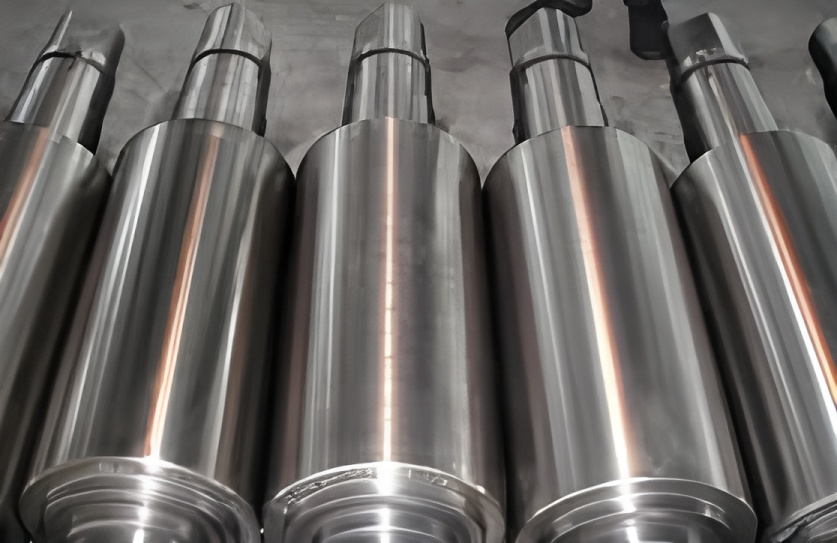Forged Steel Cold Rolling Work Rolls: Q&A (Part 4)
How does magnetic particle inspection work?
A magnetic field is applied to locally magnetize the roll. At crack locations, magnetic flux leakage occurs. Magnetic particles applied to the surface accumulate at these leakage points, allowing surface cracks to be detected.
What is the principle of eddy current testing?
An alternating current generates an alternating magnetic field on the roll surface. Defects produce specific reflected signals, which are analyzed to determine the type and depth of surface flaws. This method is suitable for surface defect detection.
What are the characteristics of ultrasonic waves?
① Reflection at interfaces: When ultrasonic waves encounter a defect larger than or equal to their wavelength, they reflect back. Defects smaller than the wavelength cause diffraction rather than reflection.
② High directivity: Higher frequencies result in better directionality, allowing precise defect localization via narrow-beam propagation.
③ High energy transmission: For example, a 1 MHz ultrasonic wave transmits energy one million times greater than a 1 kHz sound wave of the same amplitude.
What is the purpose of ultrasonic testing in mill rolls?
Ultrasonic testing includes surface wave and internal flaw detection. Surface wave detection identifies surface defects to prevent early spalling, while internal inspection assesses metallurgical quality by detecting shrinkage cavities, porosity, cracks, and inclusions—preventing failures such as roll bursting. During manufacturing, quenching and tempering generate significant internal stress. Ultrasonic testing helps identify defect-induced stress concentrations that could lead to cracking. In cold rolling, ultrasonic testing is used both for internal defect inspection during roll acceptance and surface defect detection to prevent operational spalling.
How to prevent roll marks?
Preventing or delaying roll marks is critical in cold rolling and involves multiple factors: cleanliness of the rolling environment, filtration of rolling oil, surface quality of incoming material, and roll change protocols. The general approach is to achieve clean rolling conditions and minimize foreign particle introduction. Improving roll performance through material and process enhancements—such as increased matrix hardness—also helps reduce the occurrence of roll marks. Domestic and international manufacturers have introduced mark-resistant rolls by optimizing materials and manufacturing techniques.
What factors affect roll wear resistance, and how can it be improved?
Conventional cold roll materials consist of carbides, tempered martensite, and retained austenite. Tempered martensite has a hardness of about 750–850 HV, while carbides range from 900–2500 HV depending on alloying elements. Wear resistance can be enhanced by:
Selecting chemical compositions that promote high-hardness carbide formation.
Applying heat treatment processes that ensure fine, uniform carbide distribution.
Ensuring sufficient matrix strength to improve overall wear resistance.
What materials are commonly used for backup rolls?
Traditional backup roll material is 9Cr2Mo, with ~0.9% C, ~2% Cr, and small Mo additions. This material offers high surface hardness and wear resistance after heat treatment. However, modern requirements—such as deeper hardening depth (up to 75 mm unilateral for backup rolls) and improved fatigue and wear resistance—have led to the adoption of new materials like 70Cr3Mo, 50Cr4MoV, and 45Cr5MoV. These provide better hardenability, fatigue strength, and wear resistance due to adjusted Cr, Mo, and C content, alongside manufacturing process improvements.
What is the development direction for cold rolling rolls?
Driven by industry demand for higher wear resistance, surface roughness retention, accident resistance, and uniformity, cold rolling roll technology is advancing in several areas:
Increased alloy content: Use of 5% Cr, 8% Cr, semi-high-speed steel, and high-speed steel alloys to meet diverse rolling conditions.
New composite blank manufacturing technologies: Methods such as electroslag casting, CPC, and OSPRAY are being explored for producing rolls with wear-resistant surfaces and tough cores.
Advanced heat treatment and machining: Adoption of CNC machining, computer-controlled heating, and quenching equipment improves manufacturing precision, surface uniformity, and performance for high-end rolling mills.


